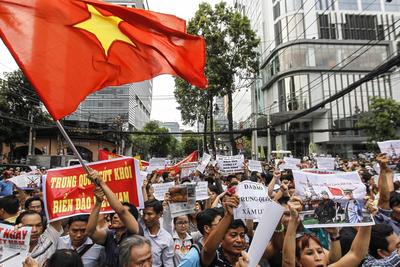These developments may fit into China’s ambitious plans to assert its maritime claims. But they do not fit into China’s ambitions to build greater structures of trust in the region. For countries like Vietnam, recent Chinese actions are seen as provocative. China is seen as willing to forcefully make its way in the territorial disputes in the South China Sea.
In terms of timing, these developments pose serious questions about China’s greater goals for its foreign policy toward its neighbouring ASEAN countries. China’s actions may be taken as possible signs that the gap between China’s good words and its deeds is getting wider — the trust deficit is growing. As a result, prospects for meaningful cooperation and efforts to build a positive image of China have taken a step backward.
In the first place, the recent developments are counter-productive to Beijing’s fresh efforts to extend the olive branch to ASEAN countries. In October last year, the Chinese prime minister, Li Keqiang, attended the 16th ASEAN–China summit in Brunei to celebrate the ASEAN–China strategic partnership’s 10thanniversary. He promoted the 2+7 cooperation framework with strategic trust as the underlying principle of good neighbourliness. He even proposed the signing of a China–ASEAN treaty on good neighbourliness.
It was expected that these developments would make ASEAN leaders at last weekend’s ASEAN Summit less willing to discuss how ASEAN should respond to China’s concept paper on the ASEAN–China Treaty on Good Neighborliness, Friendship and Cooperation — a step toward materialising Prime Minister Li’s proposal. But China’s behaviour in the South China Sea has strained the level of trust between China and ASEAN members to a new low level, making it difficult to now talk about these grand initiatives.
Additionally, ASEAN countries’ consideration of the initiative put forward by Chinese President Xi Jinping in October 2013 to build a 21st-century Maritime Silk Road may also be hindered. Next week, high-level officials from ASEAN countries and China will meet in the 8th Pan-Beibu Gulf Expanded Economic Cooperation Forum in Nanning to talk about this initiative and steps to make it happen. Again, it is expected that an exchange of words about the South China Sea disputes will take place, thus minimising the chance for the Maritime Silk Road to begin to take shape.
More unfortunately, China’s harsh behaviour in the South China Sea against Vietnam this time will serve as a fresh reminder to ASEAN leaders how difficult it has been for countries like Vietnam to approach the weight of China in the South China Sea issue. Individual ASEAN members have tried to deal with China in different ways, only to see an uncooperative and more-provocative China. The Philippines has commenced an arbitration case against China under Annex Seven of UNCLOS to determine the legal status of the nine-dashed line. Vietnam has employed various bilateral frameworks, including hot lines between top leaders and their agreements on principles to solve territorial disputes, to engage China on the issue.
When Vietnam’s deputy prime minister, Minister of Foreign Affairs Pham Binh Minh, spoke on the phone with Chinese State Councillor Yang Jiechi, he made it clear that the operation of the HD-981 drilling rig and the ships protecting it in Vietnam’s EEZ had negatively affected political trust between the two countries and peoples. Clearly, there is the perception in Vietnam, and most probably in the Philippines as well, that ASEAN as a whole has not been successful in engaging China in serious talks toward signing the Code of Conduct on the South China Sea.
Lastly, the recent developments in the South China Sea have reminded ASEAN countries of the way big power politics is operating in the region. The image of the gigantic Chinese rig and vessels — entering the area claimed by Vietnam — forcefully driving Vietnamese civilian vessels away with water cannons is cause for concern.
China’s big power mentality and behaviour in the South China Sea is unconstructive. And the ensuing impacts are negative to China’s efforts to build a positive image as well as close cooperation with countries in the region and elsewhere.
Tung Nguyen is a Senior Researcher and member of the research program on the South China Sea (East Sea) at the Diplomatic Academy of Vietnam.
The views expressed in this piece are the authors’ own.


1. An interesting case because of the issues its raises, once we get past the deep hurt in Vietnam. This is not a freedom of navigation issue, which is what the pivot Asia is ostensibly about (according to Ms Clinton, qua Secretary of State). This could be a “sovereignty” issue, on which the US has said it does not take a position, for or against any one party. This could be an EEZ issue though in an area where EEZ is ostensibly contested.
2. One important consideration is how would the US respond to this move by China in context of its pivot Asia. And how would Southeast Asia read that response.
Here is a link to a Reuter’s article which addresses the questions you raise:http://www.reuters.com/article/2014/05/17/us-vietnam-china-obama-analysis-idUSBREA4G00420140517
Many thanks you for the link.